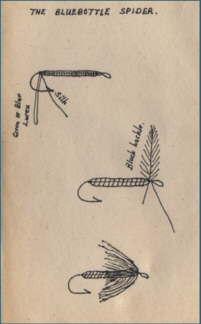Favourite Flies for the River Clyde (continued)
PROBLEMS OF THE SMUT
Dressed on hook sizes 24 and 26, these
tiny smut patterns are not too difficult to tie, as the dressing is fairly
simple. All that is required is a body of dark brown or black seal's fur, condor herl or some similar material, and a dark coloured hackle. This of course must
be very short in the flue to give a small silhouette, and as hackles of this
type and size are now practically unobtainable, a clipped hackle may have to
suffice. Wings are unnecessary.
The timing of the strike is very
important when fishing these small flies. You should allow at least three or
four times the normal time given to a trout after he takes the fly before
striking. If this long delayed strike is observed, it will be found that the
trout will almost swallow the fly, and will consequently be hooked in the back
of the throat, where these tiny hooks stand a very good chance of taking a firm
hold.
THE MAYFLY
This Mayfly takes trout both early and
late in the Mayfly season, when the more usual patterns are scorned. The
dressing is as follows:
Take a long shank size 14 or 12 light
wire hook and, after lapping the shank with tying silk, tie in a tail consisting
of a few strands of feather fibre from a duck breast feather. Mallard will do
for this purpose, but well marked Teal, Widgeon or Pintail is better. Tie in
near the bend of the hook either a thin strip of buff raffia or a strand of
light coloured floss silk, together with a length of fine copper wire. Then put
on about four turns of bright red or crimson dyed hackle, a cock hackle at the
shoulder of the fly and add a further hackle in front of this. The front hackle
is a badger hackle (white or cream with black centre) and this should be
slightly larger than the red hackle. Make about five turns with the badger
hackle.
THE BLUEBOTTLE SPIDER
|
Also known as Murray's Spider, this
extremely popular lake or river fly was invented by Mr David Murray of Hurlford
in Ayrshire. Since it was invented, however - good fly though it is in its
original form - the Bluebottle Spider has been subjected to a number of
variations. Some modern dressings give it a tail consisting of several black
hackle fibres, but the original fly had no tail, just a green fluorescent tinsel
body and a black hackle. Other versions of the fly have a blue fluorescent
tinsel body and there are variations in which the green or blue lurex tinsel was
wound on in ribbing style over a black thread body.
A striking feature of this fly is that it
can be fished with confidence from the beginning to the end of the trout season,
and is successful in any position on the cast. It is a very easy fly to dress.
|
 |
Tie in a piece of green or blue lurex
tinsel and closely wind this towards the neck of the hook. Then wind on several
turns of black hen hackle. Hook sizes 12 to 16. This is the dressing for the wet
sunk fly. If you are dressing the floating fly, use a cock hackle. The dry fly
is particularly deadly in the hot days of mid-summer and again in the autumn.
GREENWELL'S QUILL
Season - Use any time
Body:
Dark Quill
Hackle:
Red and black centre
Tail:
Dark Olive
Wing:
Hen Blackbird
DARK OLIVE DUN
Season - April
Body:
Dark Olive Quill
Hackle:
Cock hackle dyed dark olive
Tail:
Dark Olive
Wing:
Blackbird upright
Next page
|